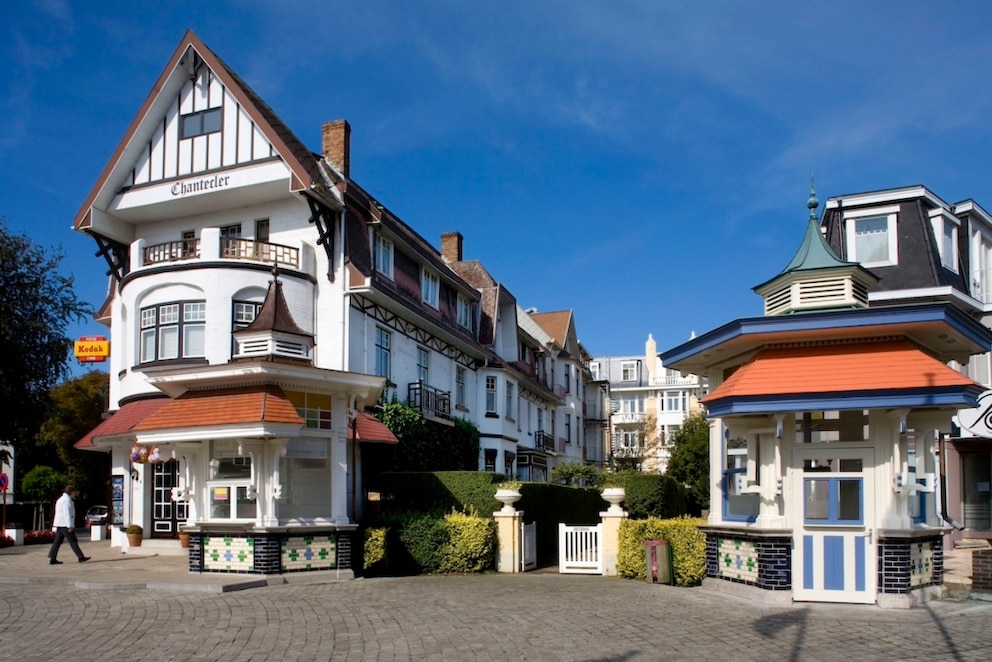May 2, 2025, 12:20 pm | Read time: 4 minutes
Hotels from the Belle Époque and elegant vacation villas define the character of the small seaside resort of De Haan on the Belgian North Sea coast. You won’t find profit-driven mega hotel complexes here.
Playful bay windows and turrets, beautifully decorated balcony railings — strolling through De Haan, one might feel transported to the 19th century. Visitors are enchanted by the charm of the seaside resort.
A three-kilometer-long circular trail leads to history and stories. Even the starting point of the trail at a tram stop is quite unusual. “Cocq sur mer” is written on the quaint waiting shelter. At that time, French was spoken on the coast. Nobles and wealthy industrialists from Antwerp, Bruges, and Brussels discovered the allure of summer retreats by the North Sea at the end of the 19th century.

Initially, they traveled by train to Oostende and had to switch to horse-drawn carriages. On bumpy tracks, they covered the last stretch of the journey to the village of De Haan, a strenuous tour.
But that changed in 1885 when the steam tram line between Oostende and Blankenberge was opened. Just a year later, De Haan was accessible by tram, and the transformation from an unknown fishing village to a noble seaside resort began.
Strolling in De Haan Is in Vogue
On De Haan’s beach promenade, people strolled during the beautiful era, the Belle Époque. Seeing and being seen was what mattered. Conversations with old friends and new acquaintances were made, business deals were initiated, and marital companionships were also established. The fresh sea air was invigorating.
Opulent inns emerged between the beach and the tram stop Cocq sur mer: Just a few hundred meters away, the Grand Hôtel Bellevue opened its doors in 1912, followed by the Hotel Astoria in 1929 with Art Deco elements on the facade. Both hotels still uphold the tradition of upscale hospitality today.
The Erfgoedwandelroute is a cultural heritage walking trail that leads into that very past. As early as the end of the 19th century, savvy entrepreneurs from Antwerp, Bruges, and Oostende recognized the signs of the times: Beach vacations on the North Sea coast would boom.
On May 27, 1889, the Belgian state, as the landowner, granted them a concession (Flemish: Concessie) for about 50 hectares of dune land in a 90-year lease agreement.

Luxury District Follows the Idea of English Villa Parks
Private individuals could now lease a plot of land from the entrepreneurs and build vacation villas there. In 1910, the Aachen architect and city planner Josef Stübben — who also planned the Cologne Neustadt — designed the entire villa district.
Stübben designed the Concessie district following the idea of English villa parks. The central place became the circular “La Potinière” with several tennis courts, mini-golf courses, and playgrounds.
The houses had to be built in a combination of the local style with red tile roofs, white stone facades, and an Anglo-American look with half-timbering, corner turrets, and the then-popular Art Deco elements. High-rise buildings were strictly prohibited. The noble French seaside resort Arcachon near Bordeaux served as a model for the architectural style.

Investors Prefer to Bypass De Haan
When the lease agreement expired in 1979 and the Concessie district reverted to state ownership, the fate of the quarter seemed sealed. Would investors now seize the valuable dune land? Would they erect concrete-gray apartment buildings like in other places along the only 65-kilometer-long coastal strip since the 1960s?
That did not happen, as residents and tourists protested. Ultimately, investors bypassed De Haan due to the ban on profitable high-rises. The Concessie district, several historic buildings, and the waiting shelter at the tram stop were gradually placed under monument protection until 1995.

Prora to be officially declared a health resort

The best route for a road trip along the French Atlantic coast

TRAVELBOOK editors reveal their favorite destinations
Traveling to De Haan
Travel: Traveling by train is comfortable, for example, from Cologne. From there, head to Liège to the Liège-Guillemins station. Here, transfer to the train to Oostende and from there continue to De Haan with the Kusttram.


